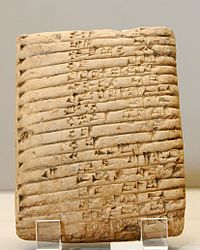
Back قائمة حكام عيلام Arabic Elam hökmdarlarının siyahısı Azerbaijani Llista de reis d'Elam Catalan Liste der Könige von Elam German Anexo:Reyes de Elam Spanish فهرست شاهان ایلام Persian Luettelo Elamin kuninkaista Finnish Liste des souverains d'Élam French Elám uralkodóinak listája Hungarian 엘람의 통치자 목록 Korean
| King of Elam | |
|---|---|
 | |
| Details | |
| First monarch | Peli (king list) Hishep-ratep (verified) |
| Last monarch | Atta-hamiti-Inshushinak II |
| Formation | c. 2500 BC |
| Abolition | 520 or 519 BC |
The kings of Elam were the rulers of Elam, an ancient civilization and kingdom in south-western Iran. The earliest known Elamite dynasty was the Awan dynasty, which came to power in the Early Dynastic period. Elam was conquered by the Akkadian Empire around 2325 BC and was then ruled by a sequence of Akkadian-appointed governors before independence was restored a little over a century later. After the reign of the powerful Elamite king Puzur-Inshushinak, Elam was conquered again c. 2100 BC by the Sumerian Third Dynasty of Ur. Native Elamite rule was after a few decades restored under the Shimashki dynasty during the reign of Ur III king Ibbi-Sin. In c. 2004 BC the Shimashki king Kindattu sacked Ur, whereafter Elam became fully independent. The Sukkulmah dynasty, perhaps a related lineage, was established in another part of Elam shortly thereafter, and after a period of overlap gradually overtook the Shimashki dynasty.
The Sukkalmah dynasty was followed by the Kidinuid and Igihalkid dynasties, whereafter the Elamite kingdom reached the height of its power under the Shutrukid dynasty. Powerful Shutrukid kings, such as Shutruk-Nahhunte I and Shilhak-Inshushinak, exerted dominion over not only Elam itself but also over Babylonia. The kingdom may have disintegrated following the defeat of Hutelutush-Inshushinak by the Babylonian king Nebuchadnezzar I in the late 12th century BC, but a new line of rulers are attested in Elam from the early 8th century BC onwards. The so-called Neo-Elamite kingdom came under the rule of the Hubanid dynasty in the early 7th century BC, which initiated a short period of intense internal conflict and meddling in Assyrian and Babylonian affairs. The Neo-Elamite kingdom was effectively destroyed by the Assyrian king Ashurbanipal in 646 BC, though Elamite rulers continued to govern the Elamite heartland until the rise and early years of the Achaemenid Empire in the late 6th century BC.
The Elamites created a new kingdom, Elymais, around 147 BC. Initially ruled by the Kamnaskirid dynasty, Elymais often fell under the control of the Parthian Empire as a vassal state, and eventually came under the rule of a cadet branch of the Parthian Arsacid dynasty. Following the fall of the Parthian Empire and the rise of the succeeding Sasanian Empire in the early 3rd century AD, Elymais was conquered and abolished as a distinct kingdom, marking the final end of Elamite political history.